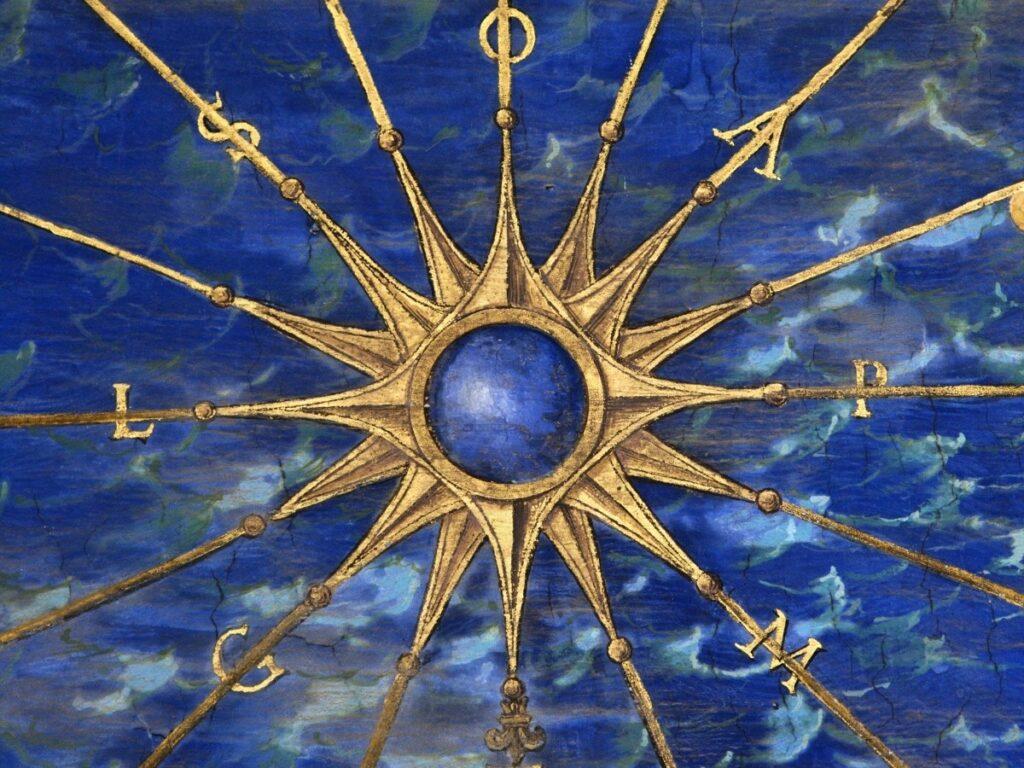A compass rose has been a functional part of travel, particularly by sea, for centuries. It is so ingrained into the life of a sea captain that it has become one of the most enduring symbols of nautical decor.
It is also often referred to as a wind rose since earlier maps made no differentiation between a directional point and the wind which emanated from that direction.

Although the compass rose was most often used as a diagram or image on a map, nautical chart, or a monument to denote the geographic orientation of North, East, South and West, they have since become a beautiful and meaningful decor accent perfect for anyone who loves travel or the sea.
Although the concept of a compass rose can be found on almost all navigation systems, it has also become a unique and simply beautiful element to add to home decor.
Considered to be grounding by some and inspirational by others, the compass rose creates a unique viewpoint that can be seen as centering them in their home.

It can also be a way to connect their environment to the world around them and/or as a reminder that there is so much out there… in all directions… to experience and enjoy.
Those who love to travel, especially those with a nautical mindset, truly love having a compass rose in sight at all times, which makes compass rose wall art such a unique and inspiring addition.
Shop Compass Rose Decor
The History of the Compass Rose
The compass rose has appeared on maps and charts from the beginnings of the 14th century. That was the time when the portolan charts first made their appearance. The portolan charts were known for their characterized by rhumb lines that radiate from the center in the direction of wind or compass points.

These charts were used by a ship’s pilot to lay courses from one harbor to another. These charts were often drawn on vellum paper and could usually be seen embellished with a frame or other decorations.
The term “rose” comes from the compass points resembling the petals of a rose in bloom.
Originally, a compass rose was used to indicate the directions of the winds, which is why it is also commonly referred to as a “wind rose”.

The 32 points of the compass rose come make up the directions of the eight major winds, the eight half-winds, and the sixteen quarter-winds. Each of the major winds had a name, and you would see the initials of these winds labeled around the edges of a portolan chart.
The names of the eight major winds, and the corresponding direction of the wind, are:
- Tramontana (N)
- Greco (NE)
- Levante (E)
- Siroco (SE)
- Ostro (S)
- Libeccio (SW)
- Ponente (W)
- Maestro (NW)
An apprentice seaman would be required to “box the compass”, which meant learning and then naming all the points on the compass correctly.
Each school of cartographers seems to have developed their own standard for drafting a compass rose, which is why you can find so many variations of the compass rose design.

Earlier charts utilized a spear above the letter T to indicate North. This symbol eventually transformed into a fleur de lis. At some point in the 14th century, the L (for Levante) on the east side of the rose was replaced with a cross, indicating the place where Christ was born, as well as the direction to Paradise, which was thought to be in the East.
From a design standpoint, the colors typically had a more utilitarian than a decorative function. To improve visibility, especially at night or during a storm, the directional points had to be easy to read. That is why the eight main points on a compass were usually drawn in black, as it provided the best contrast.
The points representing the half-winds are usually added in blue or green, with the quarter winds outlined in red.
However, for the purposes of home decor, the colors get changed quite frequently to match a particular decor style or aesthetic appeal.

Because of those simple yet useful beginnings, the compass rose has become an enduring symbol of travel, adventure, and of finding your way home.
The compass rose is nothing but a star with an infinite number of rays pointing in all directions. It is the one true and perfect symbol of the universe. And it is the one most accurate symbol of you.
Vera Nazarian, The Perpetual Calendar of Inspiration


